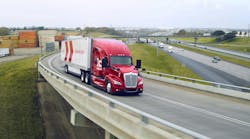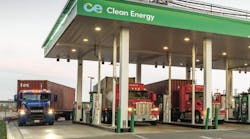To hear Brad Hicks, the integration of axle and brake on commercial vehicles is an engineering approach yet to be fully leveraged.
“There are commercial obstacles to integrating the structure of the brake onto the axle due to the building-block approach to sourcing common in the industry,” he allows. “It's really a matter of picking and choosing where integration would be most appropriate.”
Hicks says the choicest spot would be on the steer axle. “Because of the greater complexity on steers, the payoff would be better,” he explains.
“Our belief is that over time, more OEMs will want to buy more complete systems, driven by the cost, weight and even the logistical advantages of component integration. So we are positioning our capability to do that. For example, we already have a programs in place with several OEMs to supply completely dressed axles.
“Another frontier for integration,” he continues, “is the axle and suspension. Our AdVANtage integrated air-ride trailer suspension module for van and reefer trailers introduced last year is an example of this trend.”
“Integration is certainly easier to do on the trailer side simply because many truck OEMs regard suspensions as proprietary components that are important distinguishing features of their vehicles,” Hicks points out.
“But customer demand for low-maintenance components remains a key concern and a potential selling point for such integration,” he continues. “That's the thinking behind our LMS (Low Maintenance System) options for wheel ends, steer axles and brakes.” The LMS packages provide various benefits including longer warranty coverage on certain components.
Another trend Hicks says Dana will continue is the design of axles with higher torque and horsepower capacity within lighter, more compact packages. “This approach started a few years back with our DSH40 axle, which was designed for engines rated up to 650 hp. and developing 1,850 or 2,050 ft.-lb. of torque.”
What makes these axles stand out, according to Hicks, is their “high-power density” design. “This technology developed out of the need for gross axle weight ratings that were not ‘one size fits all.’ The reality is bigger engines work torque-carrying components harder. In light of the growing popularity of high-powered engines, we sought to increase our own product performance.
“Instead of jumping to a bigger axle,” he continues, “we decided to use technology to increase the capacity of the standard axle. The resulting ‘high-power density’ axle relies on a combination of improved materials and processing of the torque-carrying components to achieve higher capacity with little increase in weight or unit cost.”
As for brakes, Hicks points out that his operation has been working on air disc brakes “in a big way” for four or five years. “As a result,” he relates, “earlier this year we introduced the Dana Spicer ESD225, which is an extended-service air disc brake, for 22.5- and 24.5-in. wheels. It comes equipped with proprietary linings and rotor designs that provide longer life and exceptional performance.”
“Sales of discs remain modest and mostly favored for application in which decreased fade is very important,” Hicks acknowledges. “They are currently hard to sell in the North American market because they still carry a cost premium on the original purchase price.”
Hicks believes the benefits of discs will become apparent enough over here “to eventually drive some legislation built around stopping distances” that would make them a de facto requirement.
Until that happens, though, he is willing to emphasize the disc's key benefits: “no fade, very consistent torque output side to side-which is significant when placed on a steer axle-and the ability to ‘power up’ front-axle brakes without worrying about vehicle pull.”
Hicks says that “whatever we are working on, as engineers we must be sure to ask ‘What is in it for the end user?’”
Each month this column looks at emerging truck technology issues through the eyes of a leading engineer.
Name: Brad Hicks, director of engineering, Commercial Vehicle Systems Group of Dana Corp., Kalamazoo, MI
Background: Hicks holds a Bachelor's in Mechanical Engineering from Case Institute of Technology (Case Western Reserve University). He joined Eaton Corp. in 1973, and held positions at its former Axle & Brake Div., Hicks joined Dana in 1998 when it acquired the division. He was named to his current position in November 2000.


